Bou-Hedma Overview
Bou-Hedma National Park, locally known as Parc National de Bou-Hedma, is a captivating expanse of natural beauty situated in central Tunisia. Covering an area of approximately 164 square kilometers (63 square miles), the park lies on the northern edge of the Saharan Atlas Mountains, creating a unique blend of arid landscapes and rugged highlands. Established in 1980, Bou-Hedma is one of Tunisia’s most significant protected areas, offering a glimpse into the country’s diverse ecosystems and efforts to preserve its natural heritage.
The park’s terrain is defined by rolling hills, open plains, and the foothills of the Jebel Bou-Hedma, the park’s namesake mountain range. The rugged slopes and scenic vistas provide a stunning backdrop for visitors exploring the area. Although the park does not feature waterfalls, its seasonal streams and oases are lifelines for both wildlife and vegetation, creating lush patches amid the arid environment.
Bou-Hedma National Park is renowned for its role in the conservation and reintroduction of endangered species. The park is home to a thriving population of addax antelopes and scimitar-horned oryx, both of which were once extinct in the wild. These majestic animals roam the park’s open plains, offering visitors a rare opportunity to observe them in their natural habitat. Other notable species include Barbary sheep, gazelles, and wild boars, which navigate the park’s diverse terrain.
Birdlife is another highlight of Bou-Hedma, with over 200 recorded species gracing its skies, grasslands, and scrublands. The park provides critical habitats for resident and migratory birds, including the houbara bustard, golden eagle, and various lark species. The park’s birdwatching opportunities attract ornithologists and nature enthusiasts alike, making it a prime destination for avian observation.
The flora of Bou-Hedma National Park is equally remarkable. The park is home to an array of plant species adapted to its semi-arid climate, including acacia trees, wild olives, and various types of grasses and shrubs. These plants play a crucial role in sustaining the park’s wildlife and preventing soil erosion in this fragile environment.
Conservation efforts are central to Bou-Hedma’s identity. Established as part of Tunisia’s national park system, the park has been instrumental in the preservation and reintroduction of native species. It is a UNESCO Biosphere Reserve, emphasizing its importance as a site for research, education, and sustainable tourism. Local communities are actively engaged in the park’s management, fostering a harmonious balance between conservation and traditional livelihoods.
Visitors to Bou-Hedma National Park can explore its scenic landscapes through guided safaris, hiking trails, and birdwatching excursions. The park’s remote location and tranquil atmosphere offer a peaceful retreat for nature lovers seeking to connect with Tunisia’s natural heritage.
In summary, Bou-Hedma National Park is a treasure trove of biodiversity and conservation success. Its rugged landscapes, rare wildlife, and cultural significance make it a must-visit destination for travelers seeking a unique and meaningful experience in Tunisia.










































































